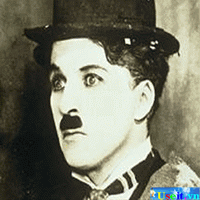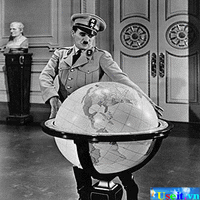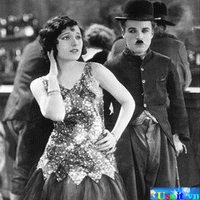Login form
Charlie Chaplin
 Charlie Chaplin (1889-1977), English motion-picture actor, director, producer, and composer, one of the most creative artists in film history, who first achieved worldwide fame through his performances in silent films. His full name was Sir Charles Spencer Chaplin.
Charlie Chaplin (1889-1977), English motion-picture actor, director, producer, and composer, one of the most creative artists in film history, who first achieved worldwide fame through his performances in silent films. His full name was Sir Charles Spencer Chaplin.
Born in
Chaplin first appeared on the screen in 1914 with the Keystone Film Company of American director Mack Sennett.
In Kid Auto Races at Venice (1914), wearing baggy pants, enormous shoes, and a bowler hat and carrying a bamboo cane, he originated his world-famous character, the Tramp. He played this classic role in more than 70 films during his career.
He was associated later with the Essanay Film Company, the Mutual Film Company, and the First National Film Company.
 In 1918 his own studio in
In 1918 his own studio in
In 1919 he helped found the United Artists Corporation, with which he was associated until 1952. Important pictures Chaplin produced, directed, and starred in include The Kid (1921), The Pilgrim (1923), The Gold Rush (1925), The Circus (1928), City Lights (1931), Modern Times (1936), The Great Dictator (1940), Monsieur Verdoux (1947), Limelight (1952), and A King in New York (1957). Chaplin wrote, directed, and played in A Countess from Hong Kong (1967). He also composed background music for most of his films.
In the late 1940s and early 1950s Chaplin was criticized for his leftist political views. As a result, he left the
Chaplin perfected an individual style of performing, derived from the circus clown and the mime, combining acrobatic elegance, expressive gesture, facial eloquence, and impeccable timing.
 His portrayal of the little tramp, a universally recognized symbol of indestructible individuality triumphing over adversity and persecution, both human and mechanical, won him critical renown as a tragicomedian. Film sound recording in the late 1920s, however, imperiled the effectiveness of the pantomime on which much of his creative imagination depended; also, he became concerned with themes of contemporary significance. In his first two films of the sound era, City Lights and Modern Times, Chaplin's little tramp remained silent.
His portrayal of the little tramp, a universally recognized symbol of indestructible individuality triumphing over adversity and persecution, both human and mechanical, won him critical renown as a tragicomedian. Film sound recording in the late 1920s, however, imperiled the effectiveness of the pantomime on which much of his creative imagination depended; also, he became concerned with themes of contemporary significance. In his first two films of the sound era, City Lights and Modern Times, Chaplin's little tramp remained silent.
Subsequently, he abandoned the role of the tramp and relied upon specific character portrayal. The Great Dictator, which uses all the resources of sound recording, marks this transition. Chaplin's treatment of his subjects compounds satire and pathos, revealing a love of humanity and of individual freedom.
He wrote My Autobiography (1964; reprinted as My Early Years,1982) and My Life in Movies (1975).

